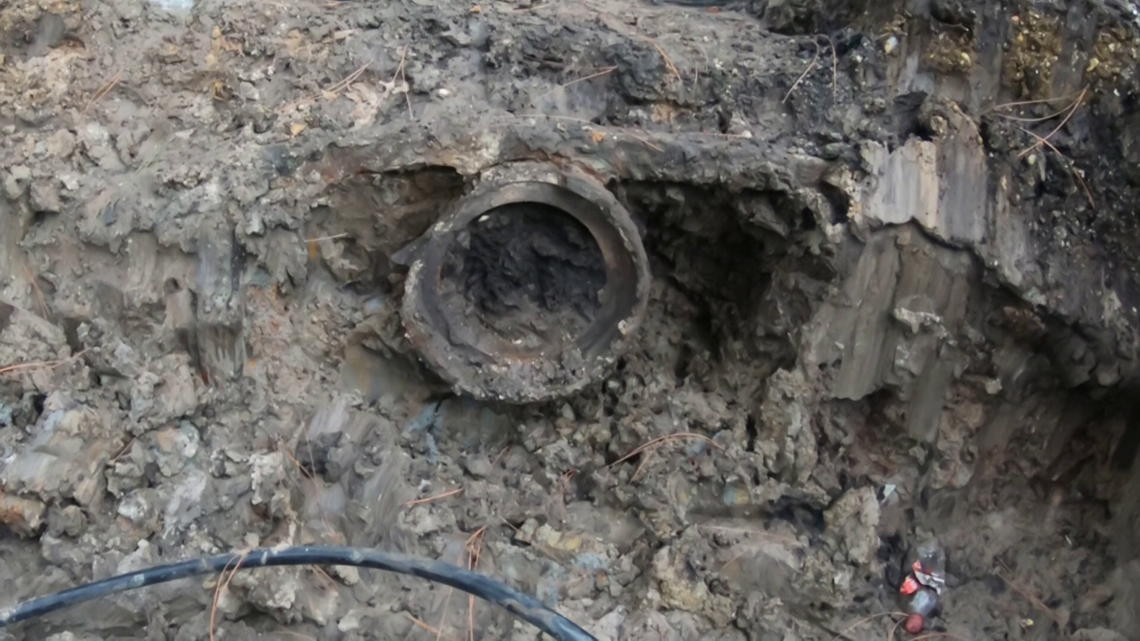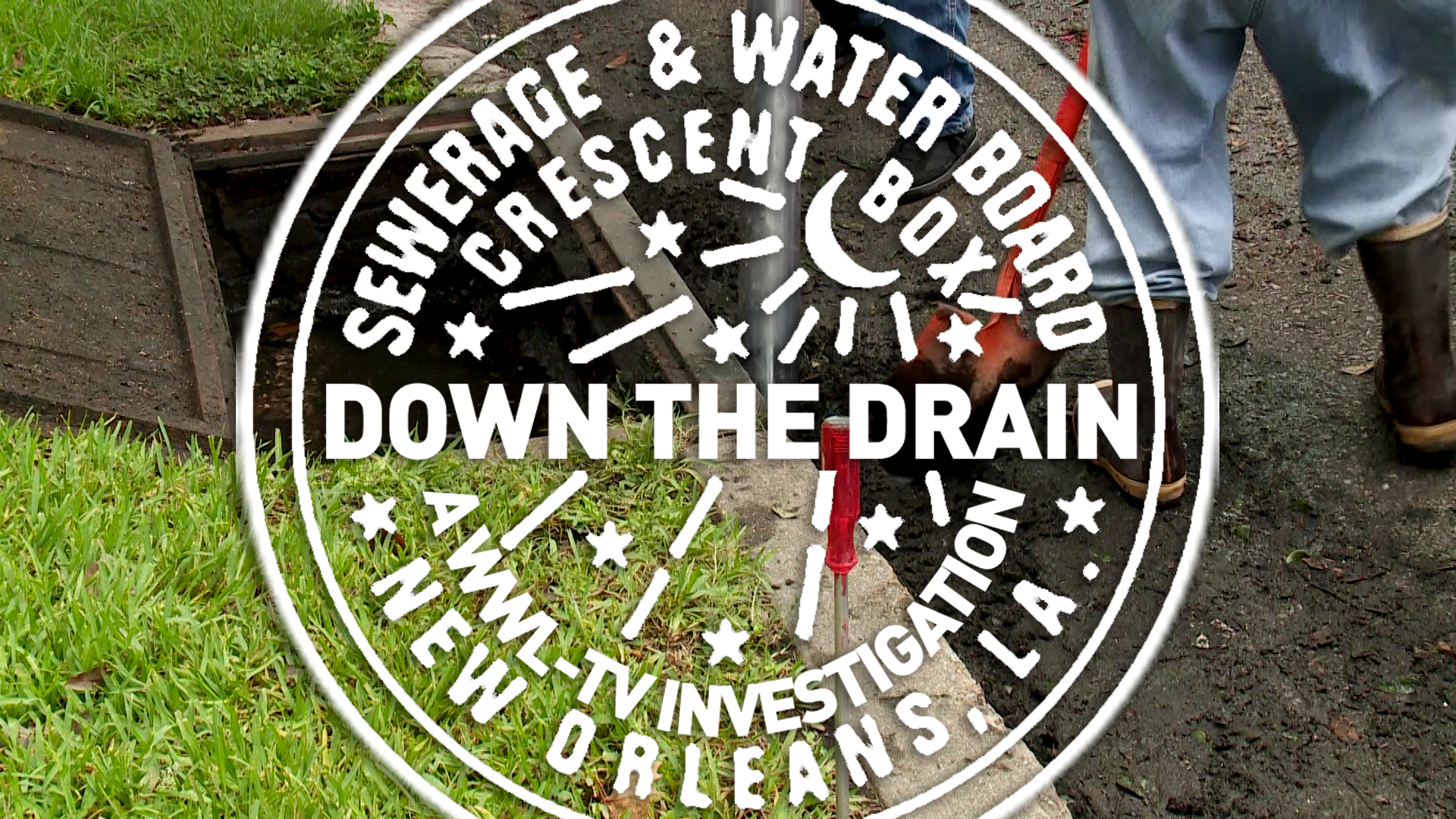NEW ORLEANS — Down the Drain is a WWL-TV investigation that explores what went wrong and where the blame lies for New Orleans' drainage crisis.
---
New Orleans’ massive drainage system has many complex parts, but the entry points for rainwater is the same throughout the city: about 72,000 catch basins and the pipes that connect them to the rest of the system.
And as repairs are made to larger machinery such as pumps and the power that operates them, catch basins and connecting pipes – known as laterals – are emerging as one of the weak links in the city’s ability to keep floodwaters from rising.
“If they're saying the pumps are working and we're still having water here, there's a problem somewhere, between here and the pumps,” Joe Otillio of Fassbender Sewer and Drain. “If the pipes were good, obviously we wouldn't have this problem. It would drain.”
Fassbender has seen a spike in its New Orleans drain-cleaning business since a series of heavy storms over the summer led to widespread street flooding, including some neighborhoods that are not accustomed to being inundated after a storm.


Sometimes the problem is obvious, such as when leaves and trash visibly block the outside of a catch basin. That’s what Esperanza Arriola found outside of her 7th Ward home.
“That's unbelievable. How's water going to get in there?” Arriola asked.
Even when residents clean the outside of the drain, they find more obstructions below the surface.
Brad Oster of Mid-City tackled a clogged catch basin on his block off of Canal Street after severe flooding after the July 10th storm. But even after he and some neighbors cleared the surface, water was not draining. So they lifted the heavy drain cover and found a mess.
“It was filled to the absolute brim, compacted with what looked to me to be a very long time, with mud, leaves and a ton of roots,” Oster said.
And even with no visible blockage, above or below street level, some drains still don't drain. That's often because something is blocking the lateral pipes that connect to the rest of the system and carry water to canals and pumps.
There about 1,500 miles of these lateral pipes crisscrossing the city, and the vast majority – all pipes under 36 inches, are the responsibility of the city’s Department of Public Works.
WWL-TV found multiple areas in which catch basins have been cleaned and repaired, some even replaced, but standing pools of water accumulate after an ordinary summer shower.
“There a lot of small laterals that public works and the streets department need to be able to repeatedly check and clean,” said engineer and activist H.J. Bosworth. “These things are invisible. It's not easy to get to them.”
To clear catch basins and lateral pipes, the city uses industrial vacuum trucks equipped with pressurized hoses. But of the city’s eight trucks, three are obsolete and being sold for scrap and two are in the shop, leaving only three for the entire city.
In many respects, New Orleans is trying to catch up to neighboring Jefferson Parish. Jefferson has nine full-time vacuum truck to clean 80,000 drains and connecting pipes, and nine more trucks are added before any major storm.
New Orleans has hired outside contractors to beef up its efforts in advance of major storms, but those contractors are only used intermittently.
“It's nowhere near where this city should be,” said Ramsey Green, deputy mayor over infrastructure. “That's why when the mayor came in, she focused on getting more money to solve this problem.”
Broad Street flooding from August 2017
While Orleans and Jefferson parishes have similar drainage issues – and similar rainfall – they have vastly different resources. Mayor LaToya Cantrell and her administration vow to change that with money from tourism dollars known as the "Fair Share" deal.
New Orleans Public Works Director Keith LaGrange said he hopes to beef up his department with the tourism money by the end of 2021.
“With the mayor's Fair Share, that doubles our maintenance staff,” LaGrange said. “Right now, as you know, we have three flush trucks, on average, operating on any given day. That would increase us to 12.”
New Orleans addresses catch basin issues almost exclusively through its 3-1-1 citizen call-in system, but being understaffed and under-equipped has kept the city years behind in addressing complaints.
A WWL-TV analysis of all 3-1-1 calls about catch basin drainage problems shows pending complaints dating back to the previous administration, in some cases two years or more.
Green candidly admitted the city’s backlog.
“It's wrong,” he said.
We showed Green photographs of catch basins that remained full of water days after any rain had fallen.
“That's a problem Mike,” Green said. “And we have it all over the city. And we're doing something about it in ways that has not been done before.”
In Jefferson Parish, the organizational chart includes a director of drainage, a position that does not exist in New Orleans. In Jefferson, all drainage issues fall under its Department of Public Works, while in New Orleans, any drainage infrastructure bigger than 36 inch pipes falls outside of City Hall to the Sewerage & Water Board.
Story continues under videos
Jefferson Drainage Director Mitch Theriot said his parish also relies primarily on citizen complaints to determine where to send its vacuum trucks. But, unlike New Orleans, the backlog in Jefferson is usually measured in days, not years.
“It's never usually longer than about a week or two before we can get to a complaint,” Theriot said, adding that when his crews get caught up on citizens’ complaints they have a pro-active system of cleaning drains neighborhood-by-neighborhood.
We showed Theriot some of the photos of clogged New Orleans drains.
“I'd be in trouble in a few days if we hadn't addressed something like that,” he said.
Theriot said he has a crew of about 300 employees. In New Orleans, the Department of Public Works, which is trying to boost its numbers to 100 employees.
New Orleans officials are blunt about the challenges, but optimistic about where the city is heading.
“It's been in crisis since we've been here and well before,” Green said. “But we’re changing the narrative. We're putting the money where it should be. We're fixing these things.”
---
Read more Down the Drain:
---
WWL-TV Investigator Mike Perlstein can be reached at mperlstein@wwltv.com; Contact all of the WWL-TV Investigators at investigations@wwltv.com;
---
Problems with flooding? An unusually high water bill? The official "Down the Drain" Facebook group is the place to go. Click here to join the group.


